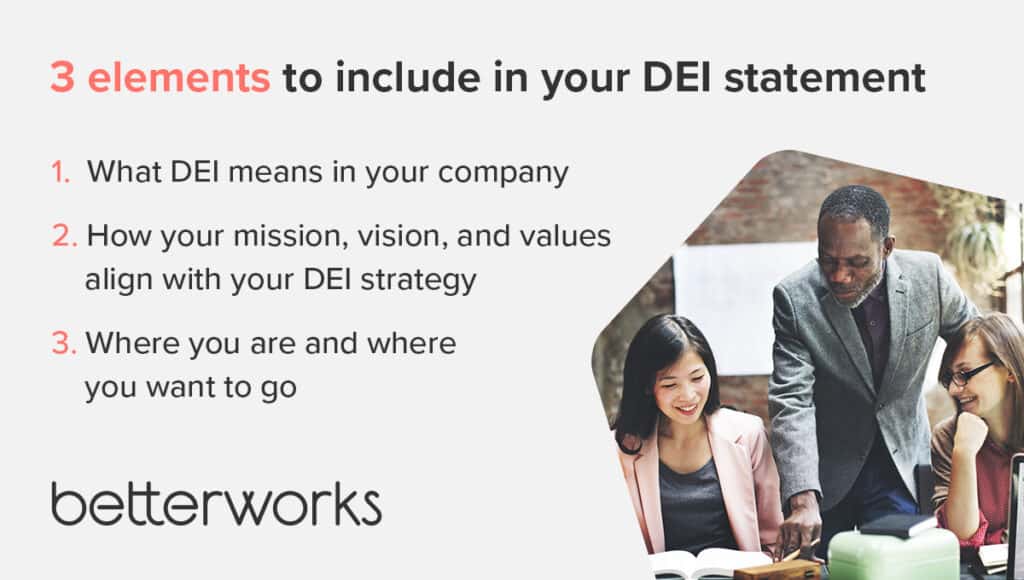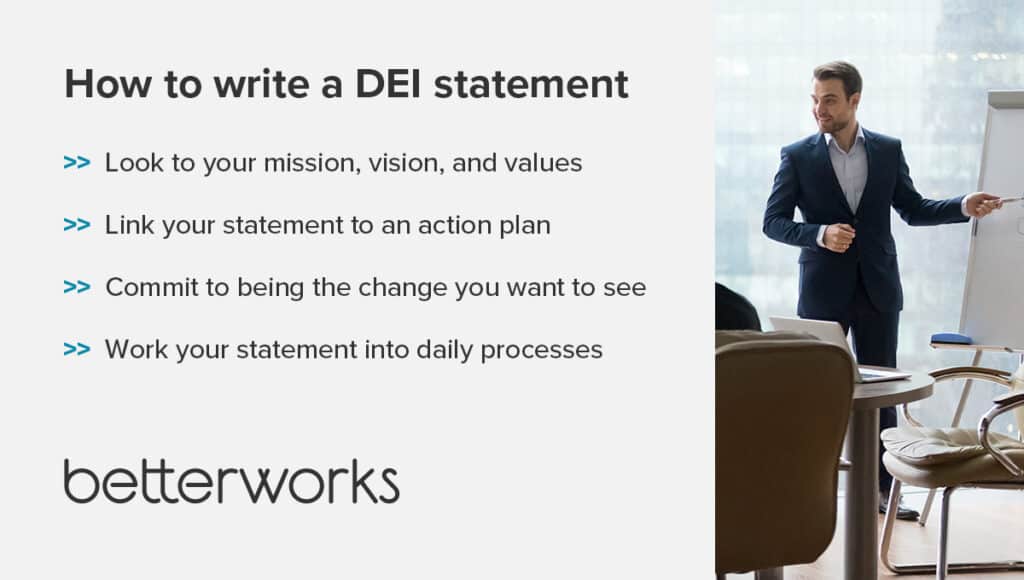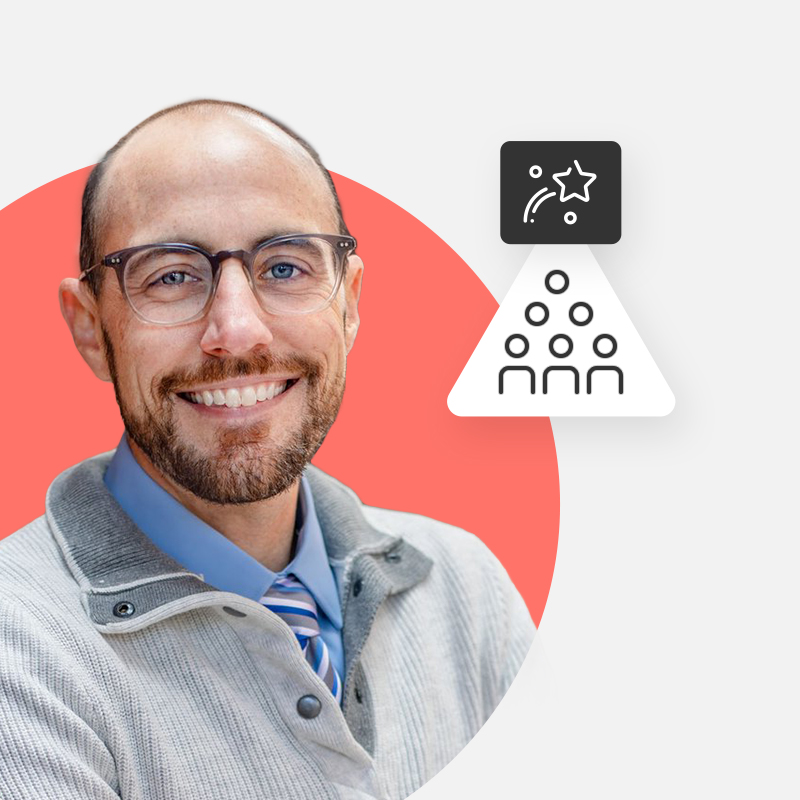- What is a diversity, equity, and inclusion statement?
- Why does your company need a DEI statement?
- What goes into your diversity and inclusion statement?
- What should you exclude from your DEI statement?
- How to write the best diversity, equity, and inclusion statement for your organization
- 3 DEI statement examples
- Change your mindset to change your actions
Words are a powerful catalyst for progress: Simply including a diversity, equity, and inclusion statement in your recruiting content can materially affect how candidates perceive your culture: as more inclusive, welcoming, and fair, a study from Datapeople reports.
Candidates aren’t the only stakeholders whose trust you can earn through a public commitment to diversity, equity, and inclusion (DEI). Your DEI statement sends a powerful message about company priorities and gives clarity to clients, customers, and employees, too.
Your DEI statement needs to candidly demonstrate where your company stands, where you’d like to go, and how you’ll get there.
Learn more about writing an effective DEI statement that attracts candidates and customers while driving positive change within your company.
What is a diversity, equity, and inclusion statement?
A corporate DEI statement is a public statement of your organization’s commitment to creating a culture that reflects your workforce’s diverse backgrounds and characteristics. DEI statements are often accompanied by specific initiatives, programs, and policies designed to foster a culture of inclusion, respect, and understanding.
And while these statements are essential to employer branding, that’s not their primary purpose. When written and implemented well, your DEI statement can be a strategic driver of change.
Why does your company need a DEI statement?
DEI statements serve two critical purposes at your company. One is to broadcast your commitment to workplace diversity and inclusion to current and potential clients, customers, and employees.
The second use is less common but no less important: To align your commitment to DEI with your overall business strategy. Your DEI statement can (and should) serve as a North Star as you build a better, fairer company culture.
What goes into your diversity and inclusion statement?
As you consider how to write a diversity statement, look at what must be included to demonstrate your commitment. Positive sentiments are helpful but insufficient, for example, so prepare to back up your words with actions.
Your statement should provide DEI definitions for your culture. It should connect DEI to your specific mission, vision, and values, and demonstrate what living your DEI statement looks like in real life.
A good DEI statement acknowledges the current state of your organization, even if the truth is difficult to admit. Transparency matters. It’s OK to acknowledge that DEI is a work in progress and that you’re making changes. Link to any public-facing diversity reporting so interested readers can see the steps you’ve already taken.
Your DEI statement should also include where you want to go. Consider what an ideal internal culture looks like, and set metrics that measure that change. For example, many companies have specific, time-bound targets for diversifying their boards and leadership.

What should you exclude from your DEI statement?
One of the worst things you can do is write a DEI statement your organization doesn’t intend to uphold. If you’re writing this as an act of self-promotion, then it’s better not to write one at all.
Leave pandering and performative commitments out of your DEI statement. For example, donating to an external cause or a charity and getting just a “thank you for your donation” letter is a great thing to do. But if you aren’t striving to create a diverse leadership pipeline internally, donating to an organization providing diverse populations with leadership training opportunities can come across as performative. If you donate to organizations that help diverse groups learn leadership skills, that’s great! Just make sure it’s not just for show, especially during this giving season.
Instead, outline the specific goals you hope to achieve, along with clear metrics for holding your organization accountable. It’s OK if you don’t meet every goal immediately, but you need to demonstrate that you did your best.
How to write the best diversity, equity, and inclusion statement for your organization
You can’t simply copy and paste another company’s DEI statement and expect it to work. Another company’s statement might inspire that workforce but be incompatible with your company and culture.
Follow these steps to write an effective diversity statement that drives sustainable change in your workforce.
Look to your mission, vision, and values
If you want your statement to create change, embed DEI into your business strategy. To do that, align your statement with your mission, vision, and values.
Start by reviewing foundational documents. Consider these questions as you draft your statement:
- What does diversity, equity, and inclusion in the workplace mean to you?
- How does your company’s mission align with DEI goals?
- How can contributions to DEI help in achieving your vision?
- Do the actions you need to take to improve DEI align with your company values?
Treat your DEI commitment as you would any other strategic business move. With your foundational documents providing direction, you can develop an action plan to reach your goals.
Link your statement to an action plan
Your DEI statement provides a direction. Use it to inform the specific actions your organization will take to enact a DEI strategy.
For example, if managers are recommending a disproportionate number of male employees for promotion, investigate why and propose solutions. It could be because the workforce is predominantly male or because your workplace culture rewards stereotypically masculine traits. To solve the problem, identify the required actions. In this example, you might focus on attracting and retaining more women and nonbinary employees, or you might switch to a performance enablement model to focus on potential and mitigate unconscious bias.
Your DEI statement should include concrete objectives that will create sustainable change. To do that, translate your action plan into public-facing goals. For example, many companies commit to increasing leadership diversity or providing specific resources to employees from underrepresented groups.
Set a specific goal that you can realistically achieve, and develop metrics for measuring your progress. Once you’ve shared those goals in your DEI statement, you’ve publicly committed to making that change happen. Your transparency will drive positive reactions and produce a sense of urgency to achieve your DEI goals.
DEI processes will overlap with HR, but examine other areas in your organization where DEI affects your processes and behaviors. Many companies are scrutinizing vendors and suppliers for their DEI commitments, for example.
Commit to being the change you want to see
DEI statements demonstrate a public commitment to change. But you must back that commitment up with proof of the work you’re doing to make a difference. This work starts with the leadership team, who set the tone — internally and externally — for what’s to come.
The strongest way for company leaders to signal their commitment to DEI is by embedding it in decision-making, strategic planning, and budgeting. Examples of this behavior include creating and funding dedicated DEI teams, updating policies and processes to support DEI outcomes, and supporting employee resource groups.
Work your statement into daily processes
Living your statement is a cultural phenomenon. Your statement will come to life in individual actions and behaviors — or won’t — based on the guidance you give employees and whether leaders set the example.
Start by moving beyond traditional diversity training programs. One-off, one-size-fits-all training rarely impacts behaviors in a tangible way. Instead, work with your learning and development team to design DEI training that functions within your specific culture. If you have international employees, for example, your workforce might benefit from cultural competency training so they can better interact with colleagues, clients, or other stakeholders from different cultural backgrounds.
To discover barriers to DEI, audit your current processes and practices. If you currently require college degrees by default from job applicants, for example, you could be excluding promising talent from talented candidates who didn’t get the opportunity to pursue higher education. In some cases, these excluded candidates will disproportionately come from historically underrepresented communities.
As your audit uncovers areas of improvement, consider how you can modify or replace ineffective processes. For example, HR leaders might work more closely with local communities to build a pipeline of entry-level talent, regardless of education, instead of sourcing college graduates exclusively.

3 DEI statement examples
One of the most challenging parts of writing an effective DEI statement is distilling all of the elements into a roughly one-page statement. Here are three companies that have written tight, effective statements.
Salesforce
The Salesforce equality webpage includes the company’s DEI statement and so much more. It links the DEI initiatives to its core values, explains why they’re so essential, and acknowledges the work that still needs to happen.
It also includes Salesforce’s current state and future goals, providing data on representation by level and role. The statement helps prospective employees and clients understand the company’s commitments and progress toward its goals.
Veterans United Home Loans
Values are front and center on the Veterans United Home Loans diversity webpage. The core value of “respect for everyone” is the backbone of the United Initiative, the company’s diversity and inclusion program.
The DEI statement focuses on valuing people and communities and gives examples of how the company lives that value daily. Testimonials from employees offer additional substance for the statement.
Booz Allen Hamilton
Booz Allen Hamilton’s DEI webpage opens with a commitment to empowering employee voices. It lays out four specific goals for advancing DEI and introduces the global business resource groups helping to make them happen.
The statement also includes an overview of relevant metrics and a link to Booz Allen Hamilton’s latest environment, social and governance report.
Change your mindset to change your actions
Your diversity, equity, and inclusion statement is an opportunity to change your organization’s mindset, behaviors, and outcomes. An effective DEI statement offers a clear path to embracing diverse voices and talent.
An effective DEI statement is the first step toward creating an inclusive culture that celebrates all dimensions of diversity and gives everyone a sense of belonging.
Want to learn more? We’ve compiled nine effective diversity and inclusion strategies.
High-Performance Teams in a Forever Changed World






